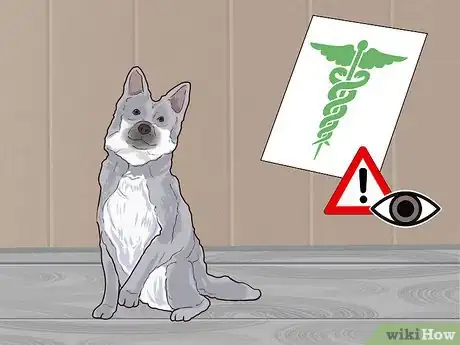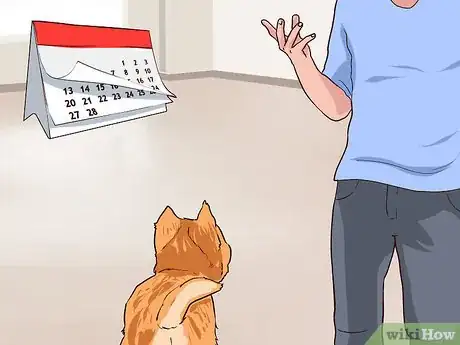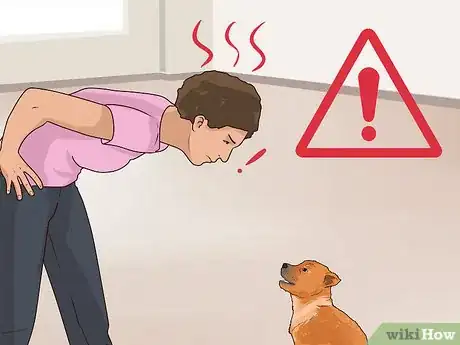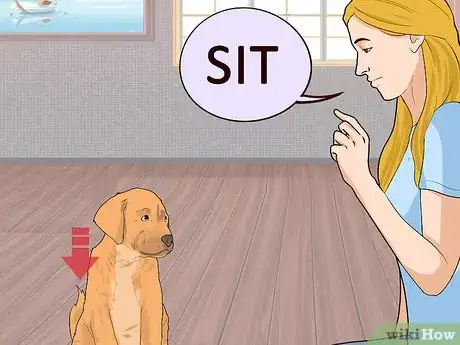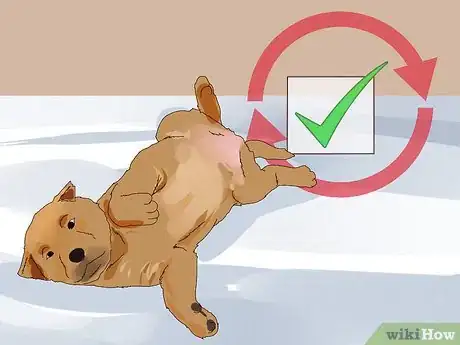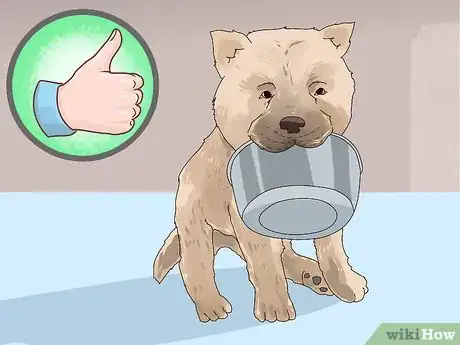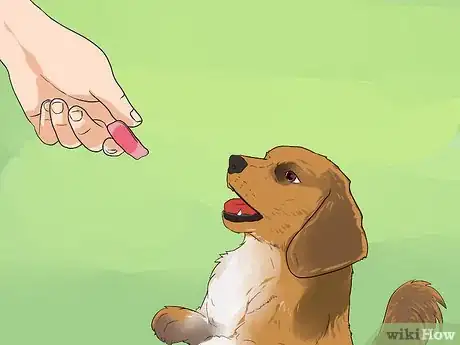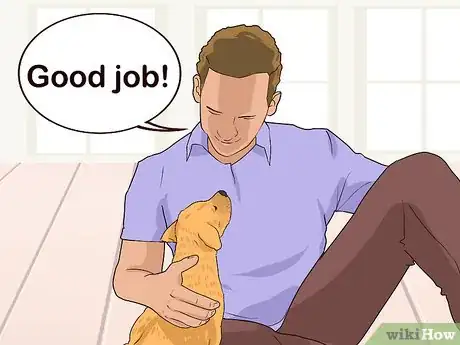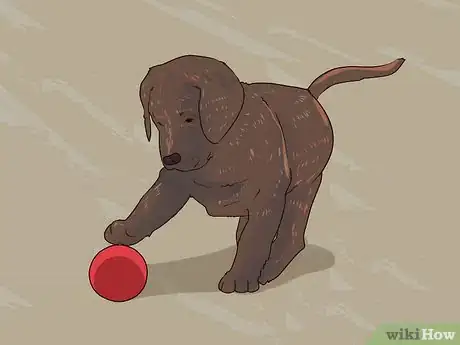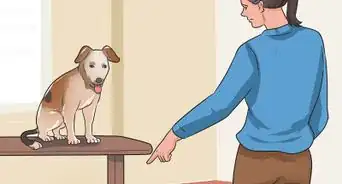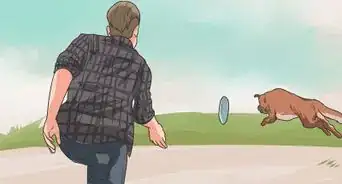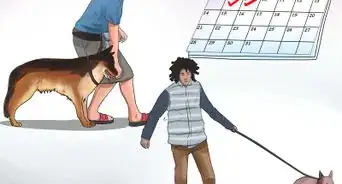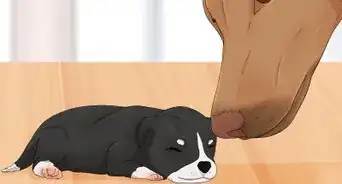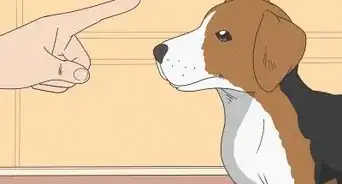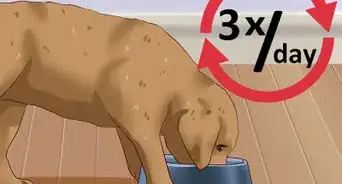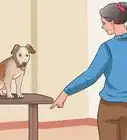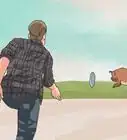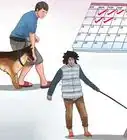This article was co-authored by Beverly Ulbrich. Beverly Ulbrich is a Dog Behaviorist and Trainer and the Founder of The Pooch Coach, a private dog training business based in the San Francisco Bay Area. She is a Certified CGC (Canine Good Citizen) Evaluator by the American Kennel Club and has served on the Board of Directors for the American Humane Association and Rocket Dog Rescue. She has been voted the best private dog trainer in the San Francisco Bay Area 4 times by SF Chronicle and by Bay Woof, and she has won 4 "Top Dog Blog" awards. She has also been featured on TV as a dog behavior expert. Beverly has over 18 years of dog behavior training experience and specializes in dog aggression and anxiety training. She has a Master of Business Administration from Santa Clara University and a BS from Rutgers University.
There are 10 references cited in this article, which can be found at the bottom of the page.
This article has been viewed 36,011 times.
Puppies have short attention spans and can become quickly disinterested in training sessions. Basic obedience training is a very important part of your new puppy’s life, but they may not always be interested in participating. You can motivate your puppy with praise, treats, and toys to encourage them to engage enthusiastically during a training session.
Steps
Preparing the Training Environment
-
1Ensure there is no medical issue present. Puppies tend to have more energy than their adult counterparts, though their energy levels vary depending on factors like their breed, age, and health. If your puppy seems to be significantly more distracted or disinterested in training than they usually are, you’ll need to eliminate any potential health factors. Your puppy might be lethargic, uninterested in food, or over-stimulated.[1]
- If you have any concerns about your puppy’s health, take them to the veterinarian as soon as you are able to. While most puppy boredom is a result of their environment, better safe than sorry applies here.
-
2Control the training environment. Like children, puppies learn the best in controlled environments. When you are getting ready to train your puppy, you should select an area that is relatively quiet and comfortable. For instance, you may decide to train your puppy indoors in your living room. This room should be quiet, free from visual and auditory distraction like the TV. It should just be the two of you. If you have other pets or small children, keep them outside of the room and dedicate this time to training your new puppy.[2]
- While you won’t be able to control for every factor, it is better to train in a quieter and more secluded environment early on. As your puppy becomes more confident in their training, you can start introducing other stimuli. This will challenge your puppy to pay attention and not be distracted.
Advertisement -
3Set an appropriate training schedule. Puppies, like small children, have short attention spans and are unable to stay focused on tasks for very long. The younger the puppy, the shorter their attention span. An 8-week puppy can only be expected to train for 3-5 minutes a few times a day, while a 4 month old puppy can train for 10-15 minutes a few times a day.[3] Remember that every dog is different, and that some puppies will respond to training more quickly than others.
- Training is a process that will go on throughout your puppy’s lifetime. As your puppy ages and reaches adolescence, usually around 6 months of age, their training capacity will change and grow, and your schedule should reflect these changes.[4]
-
4Prepare your own mental state. During these training sessions, you also need to be in the right frame of mind. If you are angry, frustrated, or feel rushed, your puppy will pick up on your cues and won’t engage in training. You should be calm and neutral during these training sessions, so your positive reactions will be understood clearly as praise.
- When you are stressed, your puppy will pick up on your cues. They may become fearful or unwilling to participate in training when they sense you are displeased with the situation.[5]
-
5Manage your expectations. Training is an important aspect of your relationship with your puppy. However, you need to be cognizant of the limitations of training. Your puppy is young and they are not able to participate in training the same way an older well-trained dog would be. They can learn basic commands, like sit and stay, but will struggle to follow more advanced commands like tricks, because of their mental capacity.[6] Keep your expectations in mind if you find yourself starting to get frustrated at your less interested puppy.
- Sometimes, you may need to pause the training session for your own benefit. It is better to revisit the training session at a later time than for you to get angry that your puppy isn’t cooperating like you think they should be.[7]
-
6Be consistent in your training and reactions. During training sessions, your puppy might seem uninterested or hesitant to participate if they feel like they don’t know what to expect.[8] This can cause stress and lead to them avoiding future training sessions. Being consistent in your tone, mood, and approach to training will help your puppy associate training with a positive activity. In turn, your puppy will become more interested in training for future sessions.[9]
- If you live in a household with other people, make sure that everyone is on the same page about training. Multiple trainers can confuse a puppy but you also want the dog to respond to each person’s commands. Consistency is key in this scenario.
Utilizing Healthy Positive Reinforcement
-
1Use appetizing and high reward treats. While most people assume that all dogs are inherently food-motivated, this may not be the case with your pup. Some breeds, like Labradors and beagles, are very food-motivated and will do anything for a treat. Other breeds are pickier with their treats, like herders and terriers, and will only respond to treats that they find truly appealing. Use high reward treats to motivate puppies who seem disinterested in training.[10]
- High reward treats are special treats that your puppy doesn’t get often, like a cube of steak or chicken, where a regular treat would be a piece of their kibble or regular food.[11]
-
2Train when your dog is hungry. Even the most food-motivated dogs will not respond to treats when they’re full. While you shouldn’t starve your puppy, they’ll be more interested in training and the prospect of treats when they’re a little hungry than they would be if they just finished a big meal. A puppy that is a little hungry will be much more willing to work for treats than a full puppy will be.[12]
- Feeding your puppy on a consistent schedule is also very helpful for other training endeavors, like for housebreaking. Wait at least two hours after feeding to train your puppy, or train right before meal time.
-
3Give out immediate rewards. Puppies, and dogs in general, do not have the same perception of time as people do. They do not understand delayed gratification and need immediate rewards to reinforce good behavior. This can be challenging at times, but it is important to be consistent. Reward them with a treat or praise as soon as they complete the command that you have just given.
- For example, when you are teaching the sit command, it is important to reward the puppy while they are still sitting rather than when they stand back up again. If you wait until they are standing again, they will think that you are rewarding them for standing rather than for sitting and following the command. This is why you need to have treats handy during your training and be quick to give verbal praise.
-
4Use verbal reinforcement and praise. Puppies, especially working breeds, want to please their owners. Verbal praise, like “good job” and “good girl” when they follow your commands will help to cement the good behavior into their minds. Puppies that aren’t interested in training will most likely be more excited and motivated by food, but verbal praise is a good way to complement your training and to make training sessions positive environments.
- You should use praise the same way as you use treats, as an immediate reward for good behavior. Be sure that you offer the praise as soon as the puppy completes the command.
-
5Use toys to motivate your puppy. Some dogs are more toy-motivated than they are food or praise driven. This means that they’d rather focus their attention on a favorite ball or plush toy than on a treat. You can incorporate toys into your training routine by holding on to their favorite toy while you give commands. This ensures that their attention is focused on you and they are willing to follow your commands for a chance to play with the toy.[13]
- You may find that your dog is more motivated by toys one day and treats another. This is fine, just be prepared to switch up your positive reinforcement methods to ensure your puppy stays excited and focused.
Community Q&A
-
QuestionHow do I teach a girl dog?
 ClydesdaleCommunity AnswerFemale dogs are no different to males, training techniques etc are exactly the same.
ClydesdaleCommunity AnswerFemale dogs are no different to males, training techniques etc are exactly the same.
Warnings
- Never hit your dog. This is abusive, will damage your relationship, and has no place in training.⧼thumbs_response⧽
References
- ↑ http://www.fidosavvy.com/bringing-home-a-new-puppy.html
- ↑ http://www.ultimatepuppy.com/how-dogs-learn/
- ↑ http://www.fidosavvy.com/how-to-train-a-puppy.html
- ↑ http://blog.smartanimaltraining.com/2013/09/09/surviving-our-dogs-adolescence/
- ↑ http://www.dogster.com/dog-training/treat-training
- ↑ http://www.aspca.org/pet-care/dog-care/common-dog-behavior-issues
- ↑ http://dogtime.com/lifestyle/dog-activities/82-basic-commands-obedience
- ↑ Beverly Ulbrich. Dog Behaviorist & Trainer. Expert Interview. 30 January 2020.
- ↑ http://www.fidosavvy.com/how-to-train-a-puppy.html
About This Article
To get your uninterested puppy excited for training, first bring it to a location that’s quiet and distraction-free, like a bedroom, so it can focus. Keep in mind that puppies have short attention spans, so it’s helpful to break up training sessions into short, 3-5 minute sessions a few times a day. As you train your puppy, make sure to give it treats when it follows a command which will keep its interest and reinforce the good behavior. If your dog isn’t interested in treats, try scheduling training sessions right before meal time so it’ll be more motivated for food. Besides giving out treats, make sure you reward your puppy with verbal praise, like ‘good job!” to make a positive training environment. To learn how to be consistent in your training sessions, read more from our Veterinary co-author!
